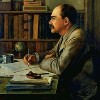 I have a list of favorite opening lines from works of fiction — in four neat stacks! — but I don’t want to show them just yet. Today, I just want to settle a few things about opening lines.
I have a list of favorite opening lines from works of fiction — in four neat stacks! — but I don’t want to show them just yet. Today, I just want to settle a few things about opening lines.
Ready for a little heresy? Then, you’ve come to the right place. Let’s go!
I realize that this is one of the Ten Commandments of writing advice in this era of slushpiles runneth over, but “Thou Shalt Write A Killer Opening Sentence” is silliness.
The commonplace idea that, without a fantastic first line, your story won’t keep readers through the first paragraph (and, consequently, without an outstanding first paragraph through the first page, et cetera, ad nauseum) is based on a premise that — upon sober analysis — is absurd.
Any reader whose attention span is so infantesimal* that you have to leash them in the first tweetlength is not a reader who is going to finish any novel-length book, no matter how engaging. And, having not finished such a book, that reader is not likely to be browsing to buy such a book in the first place. So, let’s light that straw man on fire and be done with him.
For the sake of argument, try to imagine a reader who (a) actually reads novel-length books and yet (b) requires a stellar-hot first line or else she’ll kick you straight to the curb. Such a reader would have to have some purpose driving her urgency, some reason to so feverishly cast aside any suitor who starts with anything less than a knee-wobbling icebreaker … for example, a long line of other suitors whose wooing she is also obliged to indulge.
But, what sort of reader is obliged to read the opening lines of book after book after book? Agents, editors, and publishers, that’s who!
So, it’s no wonder writers hear this advice so often, but it has very little to do with how books actually sell. Regular readers might have a smorgasbord of books to choose from, but they’re under no pressure to taste-test piles of them every day for a paycheck. They choose books for a variety of reasons, and a wham-bam first line is not likely to be the clincher in that deal.**
I Like Big Buts And I Cannot Lie
Nevertheless (which is merely a syllablicious substitute for “but”), a powerful first sentence certainly does contribute a sense of dignity and confidence to a story. It may not be a necessity, but it is one hot-damn powerful factor. A strong opening line says “I know I have a story to tell, and I’m bringin’ it from Word One.”
Now, let me backtrack a moment and spell out exactly what I mean by powerful. I still want to keep my distance from a lot of the opening line advice out there, specifically the sort that presses the writer to trick readers into being curious. I particularly dislike gimmicky hooks in first lines, the sort of head-scratchers intended to keep the reader going (at least into the second sentence) simply to figure out what what the hell the first sentence meant. Sure these puzzlers make you read on, but they set up an adversarial and suspicious relationship between writer and reader, and the writer had damn well better deliver on the puzzle.
Reality check: unless you’ve already been heralded as a literary genius by a reputable critic, the chances are good that you’re not going to deliver. Which is likely to piss the reader off. Trust me, I have been thusly pissed off as a reader.
So, let me be clear on my opinion. Trickety trappety opening lines that spit an enticing riddle into the reader’s face are of the same literary class as the titillating subject lines of spam email, or those cheaply sensational television news teasers: “Would you name your baby a number? One lady did. Find out more at 11!”
As a reader/viewer let me say: “No thank you.”
So, my four lists of Best First Lines will feature no Metamorphosis, no clocks striking 13, no exploding grandmothers. I will focus on mood and language, the clever and artful conveyance of information and feeling. In other words, first lines that are engaging without being tricky.
Also, I will group these first lines into four categories, according to what they present the reader — an engaging idea, an engaging character, an engaging setting, or a combination of these — with a little analysis following each line to excavate the key strengths underlying what the writer has accomplished.
Tomorrow’s list? The Engaging Idea.
But, don’t be quick to assume that openers based on engaging ideas are dry, intellectual, and (to writers and readers who like “human” stories) boring. Very often, this sort of opener presents an idea about human relationships, and how the characters you’re about to meet are going to stumble over it.
_
* I so wish I had coined “infantesimal,” but alas no.
** Note that this means, driven by the slushpile process or not, bookselling pros are selecting books by a standard that is somewhat orthogonal to the one that drives point-of-sale. It’s a common irrational bias called the “streetlight effect.” I won’t belabor the long-term economic effects of looking for saleability where it’s easiest for the looker to look, largely because my readers have to be pretty smart to put up with my occasional intellectual shenanigans, and can figure it out.
